PVC cutters are indispensable tools in the plumbing, electrical, and construction industries. They are specifically designed to cut through polyvinyl chloride (PVC) pipes, which are commonly used in modern plumbing and electrical systems. PVC cutters provide a quick, clean, and efficient way to cut PVC pipes, making them a must-have tool for professionals and DIY enthusiasts alike.
When working with PVC pipes, it’s crucial to make clean and precise cuts. A rough or uneven cut can lead to leaks or other issues down the line, which can be costly and time-consuming to fix. Moreover, a clean cut ensures a proper fit when connecting pipes, which is essential for the integrity of the entire system.
In this article, we will delve into the world of PVC cutters, exploring their types, uses, and benefits. We will also provide a guide on how to choose the best PVC cutter for your needs, as well as tips on how to use and maintain them properly.
Our Top PVC Cutter Picks
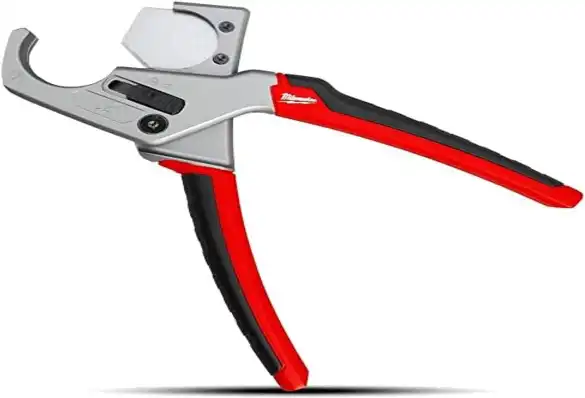
Milwaukee 48-22-4200 Pex/Tubing Cutter
Check on AmazonKey Specs:
- Blade Design: Double-ground V-shaped for cleaner cuts
- Durability: Metal core for strength and longevity
- Replaceable Blades: For extended tool life
- Locking Mechanism: One-handed lock that stays secure
- Cutting Capacity: Ideal for 1-inch tubing and PEX
The Milwaukee 48-22-4200 PEX/Tubing Cutter is designed for professionals who demand precision and durability in their tools. The double-ground V-shaped blade ensures clean cuts, especially for 1-inch tubing, making it perfect for PEX and other materials. Replaceable blades extend the tool’s life, while the metal core frame provides exceptional strength and durability. The rework groove helps fix mistakes quickly, and the one-handed locking mechanism ensures the tool stays secure in your pouch. This cutter combines user-friendly features with an indestructible design.
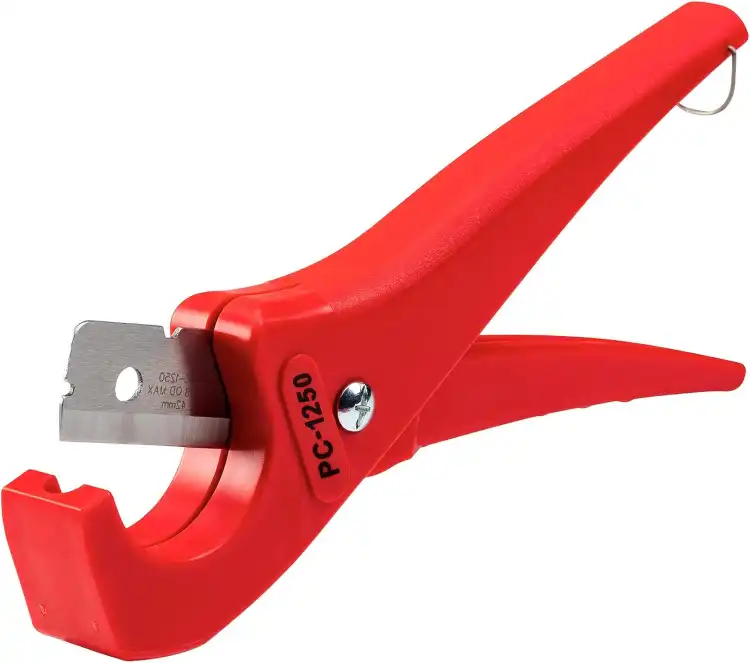
RIDGID 23488 Model PC-1250 Single Stroke Plastic Pipe and Tubing Cutter
Check on AmazonKey Specs:
- Cutting Capacity: 1/8-inch to 1-5/8-inch outer diameter
- Blade Type: Reversible blade for extended life
- Handle Type: Spring-loaded for faster positioning
- Material Compatibility: Works with PVC, CPVC, PP, PEX, PE
- Warranty: Lifetime warranty against defects
The RIDGID 23488 Model PC-1250 is an efficient and versatile pipe cutter perfect for plastic pipes such as PVC, CPVC, PP, PEX, and PE. It has a spring-loaded handle for fast positioning and a single-stroke cutting action that ensures quick, clean cuts. The reversible blade doubles its life, adding value and longevity to the tool. It can cut pipes with a 1/8-inch to 1-5/8-inch outer diameter, offering flexibility in handling various pipe sizes. Backed by RIDGID’s lifetime warranty, this tool is built to last.
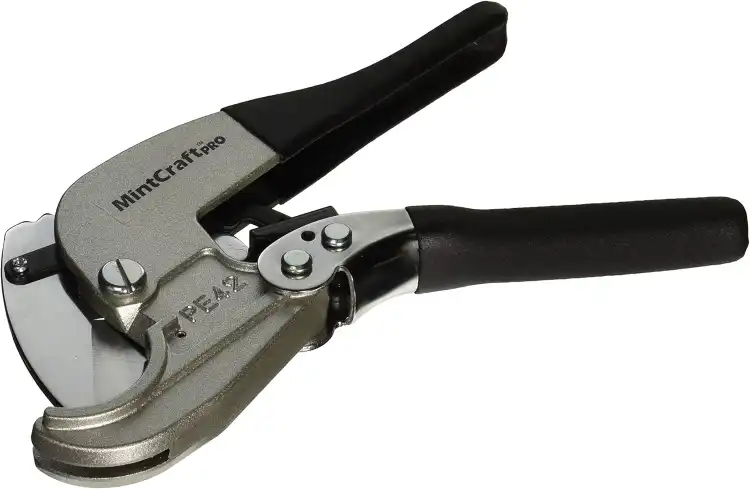
MintCraft Pro PE-42-S3L Pvc Pipe Cutter Ratcheting
Check on AmazonKey Specs:
- Cutting Capacity: Up to 1-5/8 inches diameter
- Mechanism: Ratcheting for precision cuts
- Durability: Long-lasting construction
- Material Compatibility: Ideal for PVC pipes
- Design: Ergonomically designed for ease of use
The MintCraft Pro PE-42-S3L PVC Pipe Cutter features a ratcheting mechanism that provides smooth and precise cuts, ensuring efficiency while working with PVC pipes. Capable of cutting pipes up to 1-5/8 inches in diameter, it is built for durability and long-lasting use, making it a reliable tool for both professionals and DIY enthusiasts. The design ensures easy operation, offering clean, straight cuts every time for a variety of pipe materials.
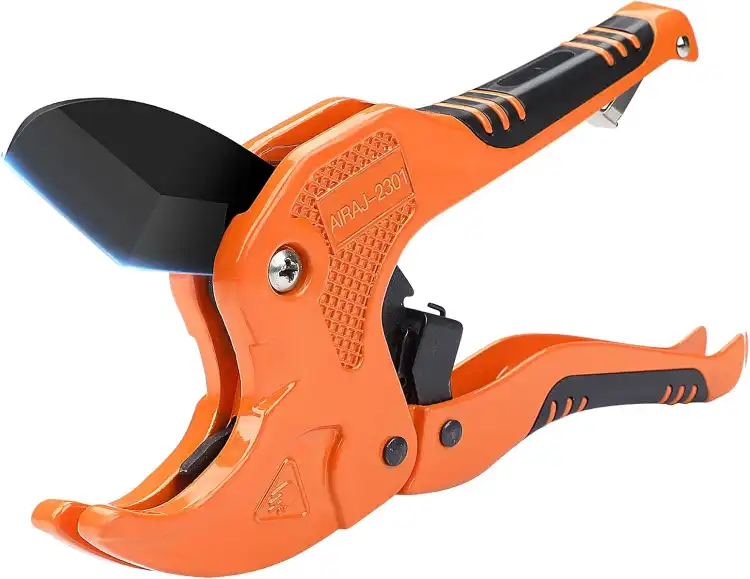
AIRAJ PVC Pipe Cutter, Cuts up to 1-3/4″, Ratcheting PVC Pipe Cutter
Check on AmazonKey Features:
- Cutting Capacity: Up to 1-3/4 inches (42 mm)
- Blade Material: High-quality manganese steel for sharpness and durability
- Ratcheting Mechanism: Enhances cutting force, saving time and effort
- Ergonomic Handle: Non-slip rubber coating for comfort and wear resistance
- Ease of Use: Simple operation, suitable for a variety of plastic pipes
- Safety Features: Designed to prevent rebound, enhancing user safety
The AIRAJ PVC Pipe Cutter is a highly efficient, ratcheting tool designed to cut through plastic pipes with ease. It features a durable manganese steel blade with high hardness, providing sharp cuts and resistance to rust. This cutter is ideal for PVC, PEX, and other plastic pipes, making it a versatile tool for various tasks. The ergonomic handle, wrapped in rubber, enhances comfort and reduces strain during prolonged use.
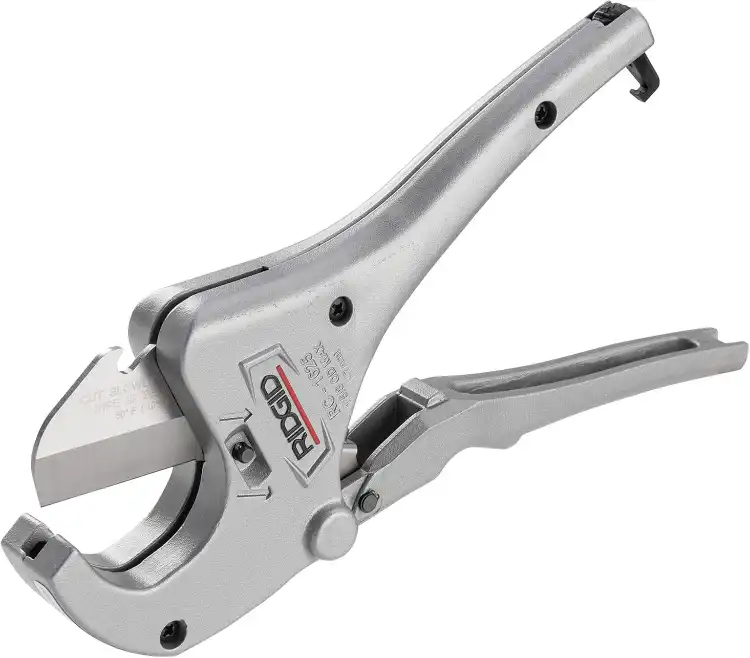
RIDGID 23498 Model RC-1625 Aluminum Ratchet Action 1/8″ to 1-5/8″ Plastic Pipe And Tubing Cutter
Check on AmazonKey Specs:
- Cutting Capacity: 1/8-inch to 1-5/8-inch outer diameter
- Material: Durable aluminum body
- Blade: Quick-change X-CEL blade
- Design: Burr-less cutting operation
- Additional Features: Ergonomic handle with built-in pipe measuring scale
The RIDGID 23498 Model RC-1625 is a game-changer for anyone who works with plastic pipes. The X-CEL quick-change blade is a standout feature, making blade replacements seamless. The burr-less cutting ensures smooth, square cuts every time, without excessive effort. The ergonomic grips on the handles make extended use much more comfortable, while the integrated measuring scale on the handle speeds up the process. It’s a solid, durable tool that delivers precision in cutting PVC, PEX, and other materials effortlessly.
Understanding PVC Cutters
PVC cutters are specialized tools used to cut PVC pipes. They are typically handheld devices that use a ratchet mechanism to gradually cut through the pipe. The blade of a PVC cutter is usually made of hardened steel for durability and sharpness. Some PVC cutters also have a built-in deburring tool to remove any rough edges after cutting.
There are several types of PVC cutters available in the market. The most common type is the ratchet-style cutter, which uses a ratcheting mechanism to gradually cut through the pipe. This type of cutter is easy to use and can cut through thick pipes with ease. Other types include the scissor-style cutter, which works like a pair of scissors, and the rotary cutter, which uses a rotating blade to cut through the pipe.
Each type of PVC cutter has its pros and cons, and the best one for you depends on your specific needs. For instance, ratchet-style cutters are great for heavy-duty jobs, while scissor-style cutters are ideal for smaller, more delicate tasks. Rotary cutters, on the other hand, are perfect for making quick, clean cuts.
Importance of Using PVC Cutters
Using a PVC cutter offers several benefits. First and foremost, it allows for clean and precise cuts. This is crucial in ensuring a proper fit when connecting pipes, which in turn helps prevent leaks and other issues. A clean cut also minimizes the risk of injury, as it eliminates sharp edges that can cause cuts or scrapes.
Another benefit of using a PVC cutter is efficiency. Compared to using a saw or other cutting tools, a PVC cutter can cut through a pipe much faster and with less effort. This can save you a lot of time and energy, especially if you have a lot of pipes to cut.
On the flip side, not using a PVC cutter can lead to several risks. For one, it can result in rough or uneven cuts, which can cause leaks or other problems. It can also increase the risk of injury, as saws and other cutting tools can slip or cause splinters. Moreover, cutting a pipe without a proper tool can be time-consuming and tiring.
Factors to Consider When Buying PVC Cutters
When buying a PVC cutter, there are several factors to consider. One of the most important is the quality of the material. The cutter should be made of durable materials that can withstand the rigors of cutting through hard PVC pipes. The blade, in particular, should be made of hardened steel or a similar material that can maintain its sharpness over time.
The size and capacity of the cutter are also important. The cutter should be able to accommodate the size of the pipes you will be working with. If you will be cutting through thick pipes, you will need a cutter with a larger capacity. On the other hand, if you will be working with smaller pipes, a cutter with a smaller capacity will suffice.
Other factors to consider include the sharpness and durability of the blade, the ease of use and comfort of the cutter, and the price. The blade should be sharp enough to make clean and precise cuts, and it should be durable enough to last for a long time. The cutter should be easy to use and comfortable to hold, especially if you will be using it for extended periods. As for the price, it should offer good value for money, providing a balance between quality and affordability.
Top PVC Cutters in the Market
There are many PVC cutters available in the market, each with its own set of features and benefits. Some of the top-rated PVC cutters include the RIDGID 23498 Model RC-1625 Ratcheting Plastic Pipe and Tubing Cutter, the Klein Tools 50031 Ratcheting PVC Cutter, and the Milwaukee 48-22-4200 Pex/Tubing Cutter.
The RIDGID 23498 Model RC-1625 is a ratchet-style cutter that can cut through PVC, CPVC, PP, PEX, PE, rubber hose, and multilayer tubing. It features an easily replaceable X-CEL quick change blade and a large, ergonomic grip for comfort. However, it is on the pricier side.
The Klein Tools 50031 is a scissor-style cutter that can cut through 1/2-inch to 1-1/4-inch PVC. It features a stainless steel blade for durability and a safety latch to prevent accidental cuts. However, it may not be suitable for larger pipes.
The Milwaukee 48-22-4200 is a rotary cutter that can cut through up to 1-inch PVC. It features a replaceable, double-ground steel blade and a rework groove to correct mistakes. However, it may not be as durable as other options.
How to Use PVC Cutters for Clean and Precise Cuts
Using a PVC cutter is relatively straightforward. First, you need to mark the spot where you want to cut the pipe. Then, open the cutter and place the pipe between the blades. Make sure the mark is aligned with the blade. Next, close the cutter and apply pressure until the blade cuts through the pipe. Finally, remove the cut piece and check the cut for cleanliness and precision.
To achieve clean and precise cuts, there are a few tips you can follow. First, make sure the blade is sharp. A dull blade can result in rough or uneven cuts. Second, apply steady pressure when cutting. Too much pressure can cause the pipe to crack, while too little pressure can result in a jagged cut. Finally, rotate the pipe as you cut. This helps ensure an even cut all around.
It’s also important to remember that safety should always be a priority when using a PVC cutter. Always wear protective gear, such as gloves and safety glasses, and make sure the cutter is in good condition before use.
Maintaining Your PVC Cutters
Proper maintenance is key to prolonging the life of your PVC cutters. After each use, clean the cutter to remove any debris or residue. You can use a cloth or brush to clean the blade and a mild detergent to clean the handle. Make sure to dry the cutter thoroughly before storing it to prevent rust.
Over time, the blade of the cutter may become dull. When this happens, it’s important to replace the blade to ensure clean and precise cuts. Most PVC cutters have replaceable blades, so you can easily swap out the old blade for a new one. Always follow the manufacturer’s instructions when replacing the blade to ensure proper installation.
When storing your PVC cutters, keep them in a dry and cool place. Avoid exposing them to extreme temperatures or humidity, as this can cause the materials to degrade. Also, keep them out of reach of children to prevent accidents.
Safety Precautions When Using PVC Cutters
When using PVC cutters, safety should always be a priority. One of the most important safety precautions is to wear personal protective equipment (PPE). This includes gloves to protect your hands and safety glasses to protect your eyes from flying debris.
Safe handling and operation are also crucial. Always hold the cutter firmly and keep your fingers away from the blade. When cutting, apply steady pressure and avoid forcing the cutter through the pipe. If the cutter is not cutting through the pipe easily, it may be a sign that the blade is dull and needs to be replaced.
Finally, always inspect the cutter before use. Check the blade for sharpness and the handle for any cracks or damage. If the cutter is damaged in any way, do not use it. Instead, replace it with a new one to ensure safe and efficient operation.
Conclusion
PVC cutters are essential tools for anyone working with PVC pipes. They allow for clean and precise cuts, which are crucial for the integrity of the plumbing or electrical system. Using a PVC cutter also offers several benefits, such as efficiency and safety.
When choosing a PVC cutter, consider factors such as material quality, size and capacity, blade sharpness and durability, ease of use and comfort, and price. There are many great options available in the market, so you can surely find one that suits your needs.
Remember to use and maintain your PVC cutter properly to ensure its longevity and performance. And most importantly, always prioritize safety when using this tool. With the right PVC cutter and proper usage, you can make your PVC cutting tasks a breeze.
FAQ
What is a PVC cutter?
A PVC cutter is a specialized tool used to cut PVC pipes. It typically uses a ratchet mechanism to gradually cut through the pipe, providing a clean and precise cut.
Why should I use a PVC cutter?
Using a PVC cutter allows for clean and precise cuts, which are crucial for the integrity of the plumbing or electrical system. It also offers efficiency and safety benefits.
How do I choose the right PVC cutter?
A: When choosing a PVC cutter, consider factors such as material quality, size and capacity, blade sharpness and durability, ease of use and comfort, and price.
